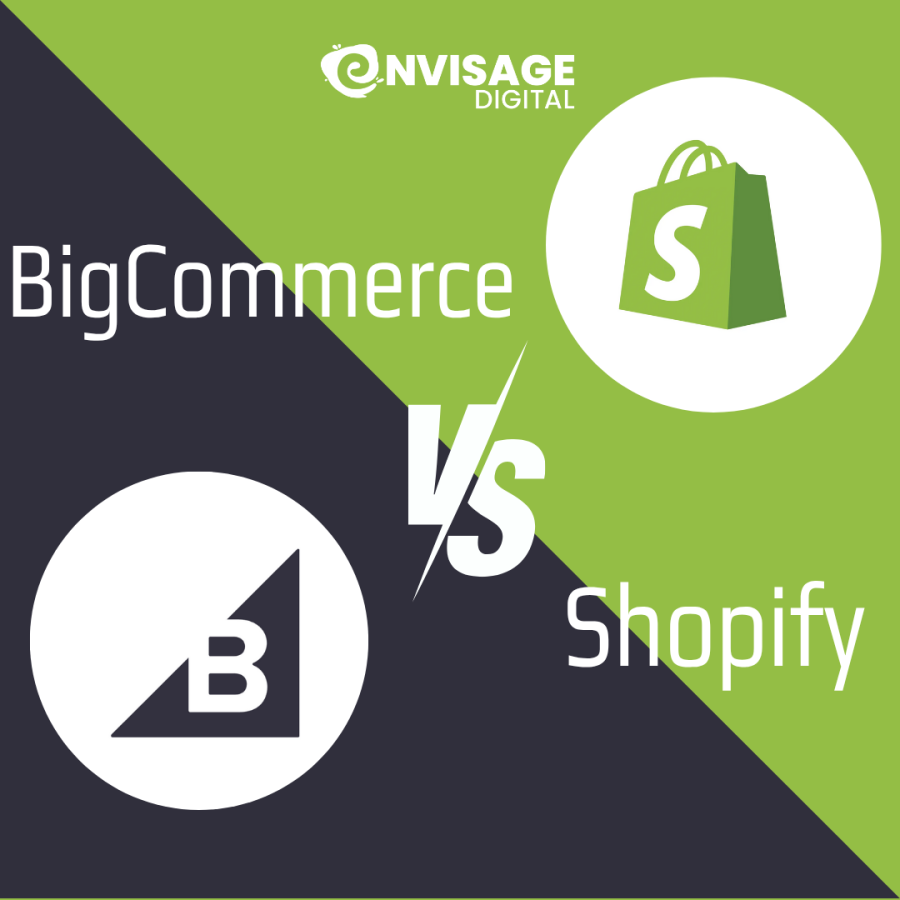BigCommerce vs Shopify: Which Is Best for Your Business ?
BigCommerce vs Shopify
Planning to build or upgrade your eCommerce store? Two names you’ve probably heard along the way are BigCommerce and Shopify. They’re both great platforms, but they have different strengths – and what’s right for one business might not be right for another.
BigCommerce and Shopify are both excellent platforms that we at Envisage Digital help clients set up and run. We’re eCommerce design and development experts, so we get to see and work with all the best bits (and also - the not so great bits) of both platforms. Let’s take a look at what each platform does well, where it could be improved; and ultimately how to decide which one is right for your business. BigCommerce vs Shopify - let's see which is best for you.
“We always start by looking at the bigger picture – your business goals, your customer journey, and how scalable you need the platform to be. Shopify can be fantastic for brands that want speed and simplicity, while BigCommerce gives you more flexibility and control if you're looking to grow and customise. There’s no one-size-fits-all answer – it's about finding what works for your unique strategy." .


BigCommerce: Pros and Cons
The Good:
* Highly adaptable – BigCommerce is developer-focused, so it’s more flexible if you need to customise for more advanced use cases.
* Built for scale – BigCommerce is great for stores with high volumes of products, or if you plan to scale in the future.
* Feature-rich – Comes with lots of great functionality out of the box: multi-currency and customer groups, B2B tools, custom domains, etc. – without needing to install a lots of additioanl apps.
* Strong security – Regular security updates and enterprise-grade security features keep your site safe.

The Not-So-Good:
* Can be more complex – You’ll likely need a developer to help you get the most out of the platform (i.e. for a more custom setup).
* Potentially more expensive – Hosting, custom builds, and scaling your BigCommerce store can be pricey.
* Performance optimisation required – You’ll need to optimise your BigCommerce platform for speed and SEO.
Shopify: Pros and Cons
Why People Love It:
Very user-friendly – Shopify is really easy to use, with a clean, intuitive design. You can set it up fast, even if you’re not very tech minded.
* Good value for entry-level businesses – Entry level and hosting plans are generally more affordable than BigCommerce – and you can find lots of pre-built themes for your store.
* Big app store – Need email marketing, recurring payments, advanced shipping, etc? There’s an app for that.
* Control – While Shopify hosts everything (files and database), you still have full control over your design, layout, and content.

What to Watch Out For:
* Lots of apps – Shopify has lots of great apps - but bear in mind lots of plugins will slow down your store (not to mention, more monthly fees).
* Not ideal for B2B / larger stores – There are B2B tools on Shopify, but overall, it’s not the ideal platform for stores with large volumes of products or customers – or those requiring lots of customisation.
* Shared responsibility on security – Updates and maintenance of themes/plugins are not handled by Shopify, so security is your responsibility.
Shopify vs BigCommerce: What About UX?
In short: Shopify is a better option if you want to get a sleek online store up and running quickly. BigCommerce, on the other hand, will let you build a more custom experience if you’re working with developers or an agency.
We asked Becky, Senior Account Manager at Envisage Digital, what she has seen when looking at user experience.
“When it comes to user experience, Shopify can often be a ‘quick win’ – especially if your team is smaller and wants something that works right out of the box,” says Becky. “BigCommerce, however, is where it’s at if you need more customisation, and want to build a bespoke customer journey." .


| Feature / Aspect | BigCommerce | Shopify |
|---|---|---|
| Ease of Use | More technical setup; developer-focused and flexible for custom builds. | Extremely user-friendly; quick setup even for non-technical users. |
| Scalability | Excellent for large or growing stores with complex requirements. | Scales well for small to mid-sized businesses; Plus plan for enterprise. |
| Customisation | Highly customisable with developer access and flexible APIs. | Customisable via apps and themes, but limited compared to BigCommerce. |
| Built-in Features | Many advanced features out-of-the-box (B2B, multi-currency, etc.). | Lean core features; relies heavily on third-party apps for extras. |
| Cost | Can be higher for hosting and development; fewer app costs. | Lower starting costs; more affordable for smaller stores. |
| B2B Support | Strong native B2B tools and pricing groups. | B2B features are limited; better on Shopify Plus. |
| Security | Enterprise-grade security, regular updates built in. | Secure hosting, but theme/app security is user’s responsibility. |
| App Ecosystem | Smaller app marketplace, more native features. | Extensive app store with thousands of integrations. |
| Ideal For | Growing or enterprise brands needing flexibility and scalability. | Startups and SMEs wanting fast, simple eCommerce setup. |
| Envisage Digital Recommendation | Perfect for complex, high-volume, or multi-channel stores. | Best for speed, simplicity, and ease of management. |
BigCommerce vs Shopify: Which One Should You Pick?
It all depends on your business, your budget and your goals. Here’s a quick overview:
Pick BigCommerce if:
* You need some good functionality that you can’t (or don’t want to) get via third-party apps
* You’re targeting B2B or multi-channel sales
* You plan to scale your business or want a headless setup
* You have a developer team (or an agency partner like Envisage Digital) to help you build and maintain your store
Choose Shopify if:
* You want to launch and manage your store quickly and by yourself
* You like the plug-and-play approach with the option of thousands of apps to use
* You have a smaller store, or your product range is simple
* You value ease-of-use over maximum flexibility
Ready to talk BigCommerce vs Shopify for your business? Contact our expert team today.
Whether you’re in the process of migrating from another platform, starting from scratch or just trying to decide which way to go, we’re here to help. At Envisage Digital, we’ve built, managed and migrated stores on both BigCommerce and Shopify, and we know what works (and what doesn’t) for different business models.
Reach out to us and let’s talk about it - practical advice to help you grow your online store.
Becky Coombes (LinkedIn) is the Senior Account Manager at Envisage Digital, with over a decade of hands-on experience in eCommerce strategy, user experience (UX) and platform development. A recognised expert in both BigCommerce and Shopify, Becky helps businesses navigate the complexities of scaling online stores, balancing technical performance with customer-centric design.
View blogs by Becky.
Latest Posts
Everything you need to become a successful eCommerce developer
Adobe has recently launched Magento 2.4.6, the most advanced version of the Magento Commerce and Open Source platform,...
Read the full blogEverything You Need to Know About the Magento 2.4.6 Update.
The day to day life of being a eCommerce developer and what it entails.
Read the full blogA Deep Dive into Magento’s Release Schedule
Dive into the heart of the Magento release schedule overhaul, uncovering its monumental shift and direct benefits for...
Read the full blog


